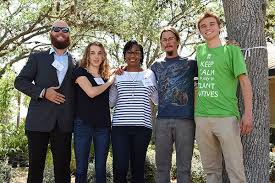Welcome to Wilcox Nursery and Landscape. I’m Bruce Turley, the owner, and this is where we are focused on native plants and sustainable products and practices.
We’re going to be talking about native plants and identifying and getting you familiar with some of our native plants. So we’re going to do a segment where we do some points of interest around the nursery and talk about some of the plant displays that you can see plants grown out.
So the question that always arises is what is a native plant?
A native plant would be a plant that occurred here naturally prior to European contact in the new world.
And why do we plant native plants?
Native plants have adapted to the diversity of environments we have in Florida and in, so they are able to help us reduce our input from fertilizer pesticides. And they’re really fantastic for providing sustainability from our pollinators to the whole chain of life. And they of course give us a sense that we know where we are as opposed to anywhere else on the globe.
In this area, we have our Coontie, our native Coontie, which is a prehistoric plant in the cycad family, a very unique plant. It’s the only place in the world where this particular species occurs.
Many of the cycads worldwide are under quite a bit of conservation stress and coontie in Florida was actually heavily exploited for use for making starch from the root. And so a lot of it has been depleted in the wild, but fortunately, it’s a super popular and super easy landscape plant. It’ll tolerate the deep shade of being under trees like in this case, it’s underneath the bald Cypress. But it will also go out into the full sun. It’s highly wind and salt tolerant, and actually tolerates quite a bit of cold as well. So it’s just a super durable plant. We lovingly refer to it as a no brainer plant.
And of course in South Florida and partially up the East coast it is the larval plant for the Italo butterfly, the Italo butterfly, because of the reduction of Coontie in the wild was once thought to be exterminated from Florida. But I think because of the plants being used so readily and landscapes that we’re seeing the major risk duration of that population. So the tree above this is bald Cypress, and again, bald Cypress is kind of the Eastern relative of the Sequoia that we’re so familiar with hearing about in California and kind of likewise, our native, bald cypress or a Cypress tree can live to be very old trees. They’re very strong constitutions and can make a great tree for moist wet areas.
In this area. With this bench, we see a ground cover growing underneath the bench that ground cover is one of our native salvias. We commonly refer to it as creeping Sage. It’s also known as river Sage. I’ve actually seen this plant growing in hammocks all the way to scrub habitat. Usually in shade, it really does seem to prefer moisture areas, but the thing I love about it as a ground cover is that it can work so well in a shade of landscape. And with that bright green foliage, it can really brighten up a darker area.
It does produce very tiny electric, blue flowers. The flowers are pretty close range. They’re also a great attractor for Cassius blue butterflies. So very commonly when they’re in bloom, you’ll see the little Cassius blue butterflies darting about the plant. Over to the side, we have alligator, Lily. The plant is not in bloom right now, but you can see the kind of typical strapped leaves that you get in that family of plants. So again, this is creeping Sage, a great ground cover for the landscape. So that’s our tour of our little vignettes here at the nursery. And if you want a dynamic 365, 24-7 plant native plants in your landscape, like our fire bush here and our goldenrods, and you will bring all kinds of life to your landscape.

